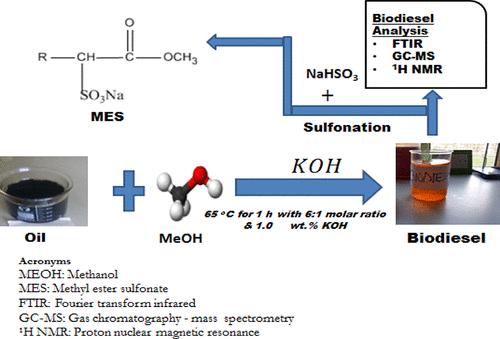Our official English website, www.x-mol.net, welcomes your
feedback! (Note: you will need to create a separate account there.)
Artificial Intelligence Techniques and Response Surface Methodology for the Optimization of Methyl Ester Sulfonate Synthesis from Used Cooking Oil by Sulfonation
ACS Omega ( IF 3.7 ) Pub Date : 2023-05-24 , DOI: 10.1021/acsomega.2c08117 Adeyinka Sikiru Yusuff 1 , Niyi Babatunde Ishola 2 , Afeez Olayinka Gbadamosi 3
ACS Omega ( IF 3.7 ) Pub Date : 2023-05-24 , DOI: 10.1021/acsomega.2c08117 Adeyinka Sikiru Yusuff 1 , Niyi Babatunde Ishola 2 , Afeez Olayinka Gbadamosi 3
Affiliation

|
Herein, the impacts of sulfonation temperature (100–120 °C), sulfonation time (3–5 h), and NaHSO3/methyl ester (ME) molar ratio (1:1–1.5:1 mol/mol) on methyl ester sulfonate (MES) yield were studied. For the first time, MES synthesis via the sulfonation process was modeled using the adaptive neuro-fuzzy inference system (ANFIS), artificial neural network (ANN), and response surface methodology (RSM). Moreover, particle swarm optimization (PSO) and RSM methods were used to improve the independent process variables that affect the sulfonation process. The RSM model (coefficient of determination (R2) = 0.9695, mean square error (MSE) = 2.7094, and average absolute deviation (AAD) = 2.9508%) was the least efficient in accurately predicting MES yield, whereas the ANFIS model (R2 = 0.9886, MSE = 1.0138, and AAD = 0.9058%) was superior to the ANN model (R2 = 0.9750, MSE = 2.6282, and AAD = 1.7184%). The results of process optimization using the developed models revealed that PSO outperformed RSM. The ANFIS model coupled with PSO (ANFIS-PSO) achieved the best combination of sulfonation process factors (96.84 °C temperature, 2.68 h time, and 0.92:1 mol/mol NaHSO3/ME molar ratio) that resulted in the maximum MES yield of 74.82%. Analysis of MES synthesized under optimum conditions using FTIR, 1H NMR, and surface tension determination showed that MES could be prepared from used cooking oil.
中文翻译:

废食用油磺化合成甲酯磺酸盐的人工智能技术和响应面法优化
在此,磺化温度(100–120 °C)、磺化时间(3–5 h)和NaHSO 3 /甲酯(ME)摩尔比(1:1–1.5:1 mol/mol)对甲酯的影响磺酸盐 (MES) 产率进行了研究。首次使用自适应神经模糊推理系统 (ANFIS)、人工神经网络 (ANN) 和响应面方法 (RSM) 对通过磺化过程进行的 MES 合成进行建模。此外,粒子群优化 (PSO) 和 RSM 方法用于改善影响磺化过程的独立过程变量。RSM 模型(决定系数 ( R 2 ) = 0.9695,均方误差 (MSE) = 2.7094,平均绝对偏差 (AAD) = 2.9508%)在准确预测 MES 良率方面效率最低,而 ANFIS 模型(R 2 = 0.9886,MSE = 1.0138,AAD = 0.9058%)优于 ANN 模型(R 2 = 0.9750,MSE = 2.6282,AAD = 1.7184%)。使用开发的模型进行过程优化的结果表明,PSO 优于 RSM。ANFIS 模型结合 PSO (ANFIS-PSO) 实现了磺化工艺因素的最佳组合(96.84 °C 温度、2.68 小时时间和 0.92:1 mol/mol NaHSO 3 /ME 摩尔比),从而获得最大的 MES产率74.82%。使用 FTIR、 1 H NMR 和表面张力测定对在最佳条件下合成的 MES 进行的分析表明,可以用用过的食用油制备 MES。
更新日期:2023-05-24
中文翻译:

废食用油磺化合成甲酯磺酸盐的人工智能技术和响应面法优化
在此,磺化温度(100–120 °C)、磺化时间(3–5 h)和NaHSO 3 /甲酯(ME)摩尔比(1:1–1.5:1 mol/mol)对甲酯的影响磺酸盐 (MES) 产率进行了研究。首次使用自适应神经模糊推理系统 (ANFIS)、人工神经网络 (ANN) 和响应面方法 (RSM) 对通过磺化过程进行的 MES 合成进行建模。此外,粒子群优化 (PSO) 和 RSM 方法用于改善影响磺化过程的独立过程变量。RSM 模型(决定系数 ( R 2 ) = 0.9695,均方误差 (MSE) = 2.7094,平均绝对偏差 (AAD) = 2.9508%)在准确预测 MES 良率方面效率最低,而 ANFIS 模型(R 2 = 0.9886,MSE = 1.0138,AAD = 0.9058%)优于 ANN 模型(R 2 = 0.9750,MSE = 2.6282,AAD = 1.7184%)。使用开发的模型进行过程优化的结果表明,PSO 优于 RSM。ANFIS 模型结合 PSO (ANFIS-PSO) 实现了磺化工艺因素的最佳组合(96.84 °C 温度、2.68 小时时间和 0.92:1 mol/mol NaHSO 3 /ME 摩尔比),从而获得最大的 MES产率74.82%。使用 FTIR、 1 H NMR 和表面张力测定对在最佳条件下合成的 MES 进行的分析表明,可以用用过的食用油制备 MES。





















































 京公网安备 11010802027423号
京公网安备 11010802027423号